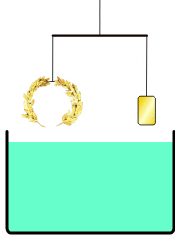Fluid could be a liquid (like water) or a gas (like air). In this chapter we will study both static fluid and the fluid flow.
The SI unit for volume is $m^3$. Unit conversion is a very basic skill for a science major. Make sure you know how to convert units to and from $cm^3$ and $L$ (liter) correctly or you will be penalized heavily. Here is a quick reminder:
$$
\begin{eqnarray}
1m &=& 100cm \tag{length}\\
\Rightarrow 1m^2 &=& (100cm)^2 = 10^4 cm^2 \tag{area}\\
\Rightarrow 1m^3 &=& (100cm)^3 = 10^6 cm^3 \tag{volume}\\
\end{eqnarray}
$$
Using the above, we get:
$$
\begin{eqnarray}
1cm^3 &=& 10^{-6} m^3 \\
1L &=& 1000cm^3 = 1000\times 10^{-6}m^3 = 10^{-3} m^3
\end{eqnarray}
$$
Density
Density $\rho$ is defined as the ratio of mass to volume:
$$
\rho =\frac{m}{V}
$$
The SI unit of density is $kg/m^3$.
Density of some common materials
| Material |
Density ($kg/m^3$) |
| Air |
$1.2$ |
| Water |
$1000$ |
| Mercury |
$13600$ |
| Gold |
$19300$ |
Try It Yourself (click to show)
Question will be loaded by load_exercise_example_all() defined in script_question.js
Question will be loaded by load_exercise_example_all() defined in script_question.js
Question will be loaded by load_exercise_example_all() defined in script_question.js
Pressure
When a force $F$ is applied perpendicularly to a plance of area $A$, it exerts a pressure given by:
$$P = \frac{F}{A}$$
The SI unit is $Pa$ (Pascals), which is equivaldent to $N/m^2$.
A common non-SI unit for pressure is $atm$, or "atmospheric pressure". To convert to SI unit, use $1atm \approx 10^5Pa$.
Pressure on a person inside a fluid (such as a diver in deep sea, or you on Earth under the atmosphere) is given by the equation:
$$
P = \rho g h
$$
where $h$ is the depth of the person in the fluid, and $\rho$ is the density. The deeper you go inside a fluid, the higher is the pressure.
If you go diving, then the pressure acting on you comes from all the water above you as well as the atmospheric pressure above the surface of the water, in that case the pressure would be given by:
$$
P = P_{air} + P_{water} = P_0 + \rho_{water} g h
$$
where $P_0$ is the atmospheric pressure.
Try It Yourself (click to show)
Question will be loaded by load_exercise_example_all() defined in script_question.js
Question will be loaded by load_exercise_example_all() defined in script_question.js
Question will be loaded by load_exercise_example_all() defined in script_question.js
Question will be loaded by load_exercise_example_all() defined in script_question.js
Question will be loaded by load_exercise_example_all() defined in script_question.js
 Out of water the gold crown weights the same as a block of pure gold. If the gold crown contains impurities that is less dense than gold, then the gold crown would have a slightly larger volume compared to the pure gold. When immersed in water, the impure crown would then displace more water than the pure gold, generating a stronger buoyant force on the crown.
Out of water the gold crown weights the same as a block of pure gold. If the gold crown contains impurities that is less dense than gold, then the gold crown would have a slightly larger volume compared to the pure gold. When immersed in water, the impure crown would then displace more water than the pure gold, generating a stronger buoyant force on the crown.




